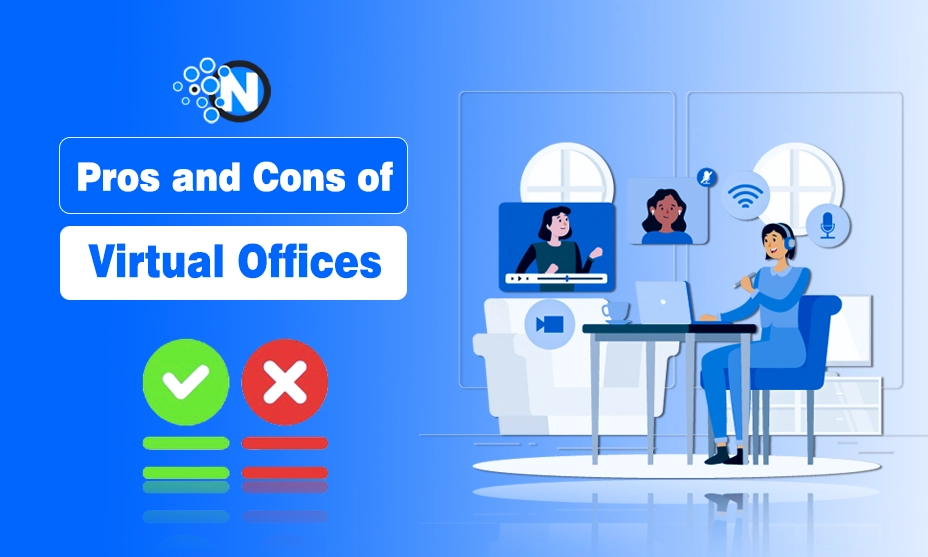The Pros and Cons of Virtual Offices in 2025 (Updated Guide)

No doubt the way we work has changed big time. Gone are the days when you needed a fancy office, a desk with your name on it, and a morning commute to prove you had a “real” job. These days, you can run an entire business from your laptop at home or while sipping coffee at a café. That’s where virtual offices come in.
Virtual offices have become increasingly popular in the modern business world as they are offering flexibility and cost-saving opportunities. But, no matter you are an entrepreneur who is looking to set up a remote office or a company aiming to optimize operations, it is crucial to weigh both the advantages and challenges of virtual offices.
So, let’s get into the pros and cons of virtual offices so that you can better understand if this approach is fully compatible for you or not.
What Are Virtual Offices?
“Virtual offices are business solutions that allow companies to operate without a physical office space. Instead of renting or owning a traditional office, businesses use digital platforms to conduct their operations.”
Virtual offices provide a business address, mail forwarding services, and communication tools like phone and video conferencing. Employees can work remotely from any location, which gives them the flexibility to manage their tasks from home, co-working spaces, or while traveling.
Virtual offices are a popular choice for startups, freelancers, and even large companies which aim to reduce overhead costs while maintaining professionalism.
The Rise of Virtual Offices
Virtual offices are changing the way businesses operate. What once seemed like a futuristic concept is now a mainstream solution. In the past, having a physical office was necessary for business credibility and operations. But today, many companies are opting for a virtual office setup.
It allows employees to work remotely, which ultimately results in reducing costs for employers and offering greater flexibility. But, like any innovation, virtual offices come with their own set of advantages and drawbacks.
Pros of Virtual Offices
The benefits of virtual offices are what have made them so popular among businesses worldwide. Here, I will break down the key reasons why so many companies are embracing this concept.
1. Cost Savings
One of the biggest advantages of virtual offices is cost savings. Maintaining a physical office can be expensive. From rent, utilities, and office supplies to maintenance costs, the expenses add up quickly. With a virtual office, businesses can save money on these overhead costs.
There is no need for a physical space, which means you don’t have to worry about paying for office furniture, equipment, or long-term leases. This approach is especially beneficial for startups and small businesses looking to minimize their initial expenses.
2. Flexibility for Employees
Another major pros of remote offices is the flexibility it offers employees. Remote work is not just a trend. Now, it has become an essential part of the modern workforce. Virtual offices allow employees to work from anywhere. Hence, it offers them a better work-life balance.
Whether they are working from home, a cafe, or a co-working space, employees can choose a location that suits them. This flexibility often leads to higher job satisfaction and productivity, as employees can design their work environment to be more comfortable.
3. Access to a Global Talent Pool
With virtual offices, businesses are no longer restricted to hiring local talent. They can tap into a global pool of skilled professionals. It opens up opportunities to recruit experts from various parts of the world.
As a result, it enhances diversity and brings in fresh perspectives. Companies can choose the best talent, regardless of location, without the limitations of geographical constraints.
4. Increased Productivity
Contrary to some beliefs, many studies have shown that remote work can increase productivity. When employees are given the freedom to work in their ideal environment, they often feel more empowered.
They can focus better, avoid long commutes, and structure their day around their peak productivity hours. Moreover, the reduction in distractions typically present in traditional office spaces allows employees to focus more on their tasks.
5. Better Work-Life Balance
A virtual office setup can also help employees achieve a better work-life balance. Working remotely eliminates the need for a daily commute, which means employees have more time to spend with family, on hobbies, or simply relaxing.
A better work-life balance can lead to increased happiness and reduced burnout, which in turn boosts overall job performance.
6. Environmentally Friendly
Virtual offices are more sustainable than traditional office spaces. Since there is no need for large office buildings, there is a significant reduction in energy consumption, including lighting, heating, and air conditioning.
Additionally, fewer employees commuting to work means fewer vehicles on the road, which reduces your company’s carbon footprint. This environmentally friendly approach is becoming increasingly important to businesses and consumers alike.
Cons of Virtual Offices
While virtual offices have many advantages, there are also challenges that need to be addressed. In the under section I have explored the potential downsides of virtual offices to get a balanced perspective.
1. Communication Challenges
One of the biggest challenges of virtual offices is communication. In a traditional office, it is easy to have quick face-to-face conversations. But in a virtual office, communication relies heavily on digital tools like emails, video calls, and messaging platforms. It can sometimes lead to miscommunication or slower response times.
Further, the absence of in-person interaction can also make it difficult for teams to collaborate effectively, particularly in more creative or brainstorming sessions.
2. Lack of Team Cohesion
Building a cohesive team can be harder in a virtual office environment. In traditional offices, employees can bond through casual conversations, coffee breaks, and team-building activities. But in virtual settings, employees may feel isolated, leading to a lack of camaraderie and team spirit.
It is important for virtual teams to make a concerted effort to stay connected, which might require additional resources and time management.
3. Security Concerns
Cybersecurity can be a significant concern for businesses operating with virtual offices. When employees are working remotely, they may not have the same level of security as they would in a traditional office. Consequently, it can make it easier for sensitive company information to be compromised.
Companies need to invest in comprehensive cybersecurity measures, such as encrypted communication tools, secure Wi-Fi connections, and employee training on data protection.
4. Lack of Work Structure
In a virtual office, employees have more freedom to structure their day as they see fit. While this can be a benefit, it can also be a disadvantage for some workers. Without the structure of a physical office, some employees may struggle with time management and procrastination.
They may find it difficult to stay focused and productive without the accountability that a traditional office environment provides.
5. Technology Issues
A virtual office setup is entirely dependent on technology, and when technology fails, work can come to a halt. Issues like internet connectivity problems, software glitches, and hardware failures can cause significant delays.
To maintain smooth operations, businesses must ensure they have reliable IT support and backup systems in place to resolve any technical issues promptly.
6. Limited Networking Opportunities
Networking is often one of the most valuable aspects of working in a traditional office. In-person meetings, conferences, and social events provide opportunities to meet new people, exchange ideas, and build professional relationships. In a virtual office, these networking opportunities are limited.
Although virtual networking tools can help bridge the gap, they may not offer the same level of personal connection as face-to-face interactions.
Tips for Managing a Virtual Office Effectively
Now that I have covered the pros and cons of virtual offices, let’s discuss how businesses can make the most of virtual offices while minimizing the drawbacks. Below are some tips for managing a virtual office effectively.
1. Invest in Communication Tools
To ensure smooth communication, invest in reliable communication tools. Tools like Slack, Microsoft Teams, and Zoom can help facilitate real-time conversations and video meetings. It is also essential to establish clear communication guidelines, so everyone knows when and how to reach out to one another.
2. Focus on Team Collaboration
To build team cohesion, make a conscious effort to increase collaboration. Organize virtual team-building activities, set up regular check-ins, and encourage employees to connect on a personal level. Virtual happy hours, coffee chats, or brainstorming sessions can help strengthen relationships and promote a sense of belonging.
3. Prioritize Cybersecurity
Since virtual offices rely heavily on digital tools, it is important for you to ensure strong cybersecurity. That’s why you should invest in secure communication platforms, encryption software, and VPNs to protect sensitive data. Also, provide employees with proper training on maintaining security while working remotely.
4. Create a Flexible Work Schedule
Allow employees to work at their most productive times. Some might work best early in the morning, while others are more productive at night. When you offer flexible work hours, you can ensure employees are working when they are most focused. As a result, it leads to better performance.
5. Regular Performance Reviews
In a virtual office, it is essential to keep track of employees’ progress. Regular performance reviews help you ensure that your team is staying on track and meeting their goals. These reviews provide an opportunity to discuss any challenges employees may be facing and offer support where needed.
Final Thoughts
These are the details about the pros and cons of virtual offices. Virtual offices are a game-changer for businesses and individuals alike. While they come with distinct advantages, such as cost savings, flexibility, and access to a global talent pool, there are challenges to consider, such as communication barriers and security concerns.
However, virtual offices can be an efficient and effective way to work by implementing the right tools, creating a collaborative environment, and building a strong team culture. The key to success lies in balancing the pros and cons, so you can make the most of what a virtual office offers.




